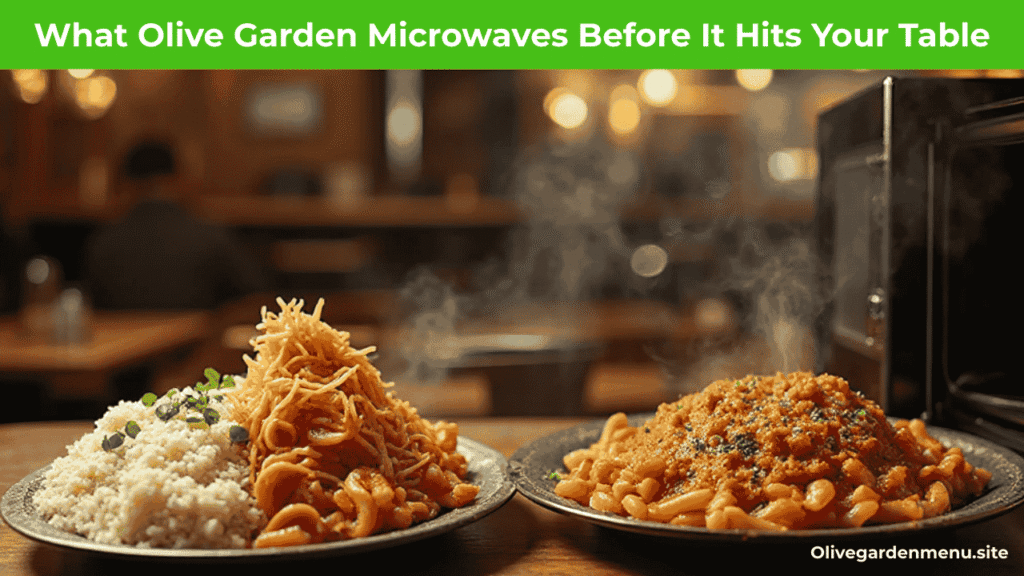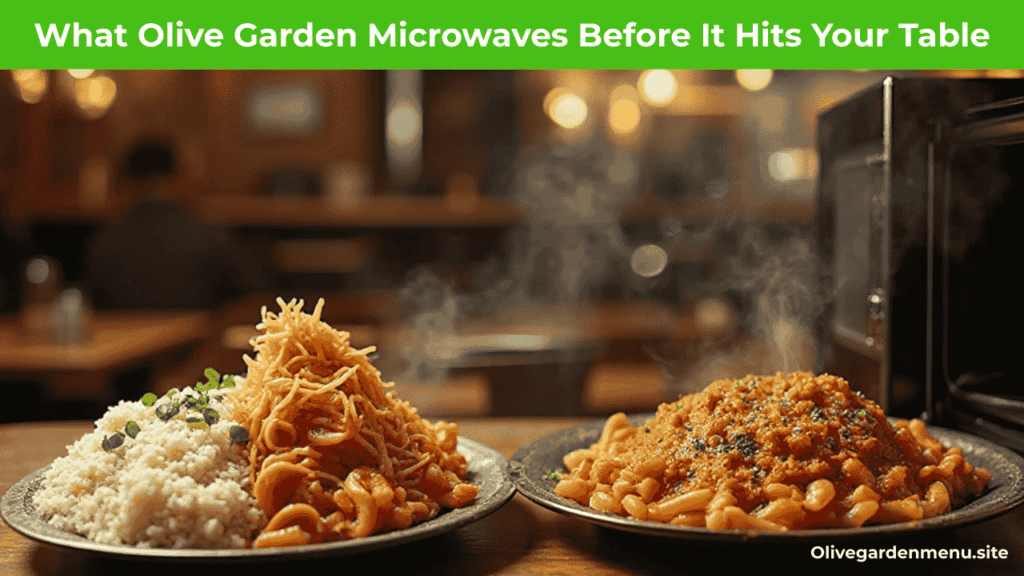I still remember the first time I went to Olive Garden as a teenager. The endless salad bowl, the garlic breadsticks, and that plate of Chicken Alfredo that landed on my table faster than I thought possible. Back then, I didn’t question how it got there so quickly. But years later, when a former server friend casually mentioned that “a lot of Olive Garden Microwaves happen behind the scenes,” I was curious. Was I eating freshly cooked food or just reheated meals?

That curiosity led me to dig deeper, read former employee stories, and compare my own dining experiences. The truth isn’t black and white. While yes, microwaves are part of Olive Garden’s kitchen routine, it doesn’t necessarily mean the food is bad or fake. In fact, understanding why microwaves are used gives you a clearer picture of how big restaurant chains actually run.
Introduction: The Truth Behind Olive Garden’s Kitchen Secrets
When most of us think of Olive Garden, we picture steaming pasta bowls and baskets of warm breadsticks. The brand markets itself as “Italian comfort food made fresh daily.” But like many chains serving millions of guests every year, Olive Garden Microwaves are part of the equation.
The question is: does it ruin the dining experience? Or is it simply a behind-the-scenes tool that ensures consistency and speed?
Do Olive Garden Meals Really Get Microwaved?

What Former Employees Have Revealed
Over the years, dozens of Olive Garden employees have spoken up online. From Reddit threads to restaurant job boards, the consensus is clear: yes, microwaves are used. Sauces, soups, and even some pasta dishes are prepped earlier in the day and later reheated before being served.
But here’s the important detail — “microwaved” doesn’t equal “frozen TV dinner.” These dishes are cooked in bulk by kitchen staff, stored safely, and then reheated in portions.
Why Microwaving Happens in Busy Restaurant Chains
Restaurants like Olive Garden juggle massive customer volume, especially on weekends. Using microwaves:
- Speeds up service time
- Reduces waste (by reheating portions instead of wasting large pots of food)
- Ensures every plate looks the same, whether you’re in Florida or California
So yes, Olive Garden Microwaves are real — but they’re not always a bad thing.
Which Olive Garden Dishes Are Microwaved?
Pasta and Sauces: Fresh or Reheated?
Pasta is boiled throughout the day and usually served fresh. Sauces, however, are often made earlier in bulk. Alfredo, marinara, and meat sauces are microwaved for individual servings. Lasagna, which takes hours to prepare, arrives pre-assembled and is reheated before serving.
| Dish | Freshly Cooked | Microwaved/Reheated | Notes |
| Fettuccine Alfredo Pasta | Boiled fresh | Sauce reheated | Classic dish with balance of both |
| Spaghetti with Meat Sauce | Pasta boiled | Sauce reheated | Meat sauce portioned from bulk |
| Lasagna Classico | Pre-made | Reheated | Arrives ready-to-bake, finished in-house |
Soups and Appetizers: What You Should Know

Olive Garden’s famous soups — Zuppa Toscana, Pasta e Fagioli, Chicken Gnocchi, and Minestrone — are cooked in large pots earlier in the day. Portions are later reheated. Appetizers like fried calamari or mozzarella sticks are cooked to order, but stuffed pastas or dips may be microwaved.
Desserts and Breads: Freshly Made or Pre-Prepared?
Breadsticks are the pride of Olive Garden. They’re baked fresh, brushed with butter, and kept warm. Desserts are mixed: Tiramisu and Black Tie Mousse Cake come pre-made, while warm doughnuts or seasonal treats are freshly fried or baked.
What’s Made Fresh at Olive Garden?
Items That Rarely See the Microwave
Not every dish gets microwaved. Proteins like grilled chicken, shrimp scampi, salmon, and steak are cooked when you order. Salads, dressings, and breadsticks are also prepared fresh.
How Olive Garden Balances Speed and Freshness
Olive Garden kitchens work in a hybrid style:
- Fresh proteins and pasta = cooked to order
- Sauces and soups = prepped earlier, reheated later
This mix allows Olive Garden Microwaves to coexist with fresh cooking.
Is Microwaving a Bad Thing for Quality?
Taste vs. Convenience: The Real Debate
The truth is, most customers don’t notice. If the food tastes hot and flavorful, it doesn’t matter if the soup was reheated. For some, however, knowing their entrée was microwaved dampens the experience.
How Microwaving Impacts Nutritional Value
Microwaving doesn’t necessarily kill nutrients. In fact, some studies suggest it preserves vitamins better than stovetop boiling. But the concern is more about texture — reheated pasta sauces may separate slightly, and reheated proteins can lose moisture.
Behind the Scenes: How Olive Garden Kitchens Operate

Prep Work Done Daily by Staff
Every morning, staff prep pasta, chop vegetables, and cook soups in bulk. This ensures Olive Garden’s signature flavors are ready for the rush.
The Role of Frozen and Pre-Made Ingredients
Like most chains, Olive Garden relies on frozen ingredients — from pre-made lasagna to dessert cakes. These are stored safely, then reheated or finished before serving.
Customer Reactions: Do People Actually Notice?
Online Reviews and Complaints
Some online reviewers complain about “lukewarm reheated food.” Others claim they can taste when a dish has been microwaved.
Why Many Still Love Olive Garden Anyway
Despite the critics, Olive Garden remains popular. Why? Because the food is consistent, affordable, and comforting. Breadsticks and salad alone keep people coming back.
Industry Comparison: Is Olive Garden Different From Other Chains?
How Olive Garden Compares to Red Lobster, Chili’s, and Applebee’s
Olive Garden isn’t alone. Red Lobster uses microwaves for sauces, Chili’s reheats ribs and fajitas, and Applebee’s does the same with pasta dishes. Microwaves are standard in most casual dining chains.
Why Fast-Casual Dining Relies on Microwaves
Without microwaves, wait times would double, waste would rise, and costs would increase. It’s the trade-off for quick, affordable meals.
Final Words:
At the end of the day, Olive Garden Microwaves don’t define the restaurant. The breadsticks are still fresh, the pasta is boiled daily, and proteins are grilled when you order. Microwaving is simply a behind-the-scenes tool to keep up with demand.
If you’re looking for authentic scratch-made Italian food, Olive Garden isn’t the place. But if you want consistent comfort food, served hot and fast, the microwaves shouldn’t scare you off.
FAQs
Does Olive Garden microwave all of its food?
No, not all dishes. Breadsticks, salads, and grilled proteins are fresh, while soups, sauces, and some pasta dishes are reheated.
Are Olive Garden soups made fresh daily?
Yes, soups are cooked daily in large batches, then reheated in portions when ordered.
What menu items at Olive Garden are always freshly prepared?
Breadsticks, salads, grilled chicken, shrimp, salmon, and steaks are made fresh.
Is Olive Garden food frozen before being cooked?
Some dishes, like lasagna and desserts, arrive pre-made and frozen, then are reheated before serving.
Why does Olive Garden use microwaves if it affects quality?
Microwaves allow Olive Garden to serve thousands of guests quickly and consistently, while still keeping costs down.



